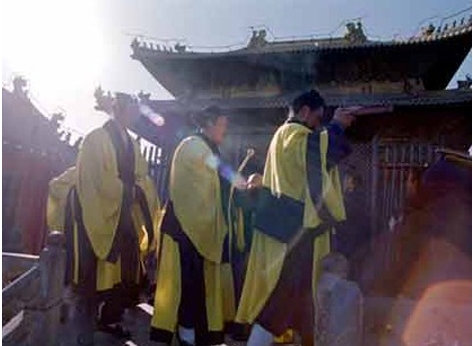
The Wudang Mountain was called Taihe Mountain in ancient times. Located in Shiyan City of Hubei Province, the mountain looks sublime and imposing, commanding the Danjiangkou reservoir and backing on Shennongjia forested area, with a continuous length over 400 km. It boasts 72 peaks. The elevation of its highest peak, Tianzhu Mountain, is 1612m. The other peaks are all inclined to Tianzhu Mountain, presenting a marvelous spectacle. From time immemorial, Wudang Mountain has always been the dreaming place for Taoists seeking fairyland. Magnificent Taoist buildings are distributed all over the mountain. The legend goes that it was the place where Xuanwu became an immortal after ascetic practices. Taoist music is also called "sacrificial music", "religious ritual music", and "Taoist rite music". It is a kind of music used for various Taoist rites. Wudang Mountain Taoist music is the product from the combination of the outstanding folk culture around Qinba and the palatial music prevailing from the Tang Dynasty to Ming Dynasty. And it is the treasure of our national music. Generally, Wudang Mountain Taoist music is the integration of "song, dance and music".
In the golden age of the Tang Dynasty, Five Dragon Shrine was initially built on Wudang Mountain. From then on, Zhengyi, Quanzhen and other sects of Taoism began to preach on the mountain one after another. Senior masters in all ages prevailed to retreat and practice there. After thousands of years, the religious activities have left extremely rich music materials. Wudang Mountain Taoist music not only remains the characteristic of "General Rhythm" of Quanzhen sect, but also featured by mixed music style of different sects. Besides, each type has complete melodies and ritual apparatus. It is the rare and important cultural heritage of Taoist music.
Since Taoism is a religion indigenous to China, it has traditional characteristic and rich ethnic style. The music, divided into vocal and instrumental music, features classic and elegant melody and rich content. There is merry music praying for lucky and happy events, and also some graceful rhythm depicting concentrative ascetic practice. Listen to fairy music and appreciate immortal doctrine, and then you will enjoy the pleasure that only exists in the paradise.
Wudang Mountain Taoist music is an ensemble of palatial music and folk music. It has two types of Pitch and Melody. Pitch can be divided into "level tone" and "oblique tone" depending on different occasions, audiences and purposes; Melody has three types of main music, incidental music and ritual apparatus. Common melody of instrumental music includes "Shanpoyang", "Wutongyue", "Yingxianke" and so on. And qu tune of chanting contains "Pugongyang", "Doulaozan", "Wangmuzan" etc. According to the activities, it can be divided into three types - Religious Rites for Doctrine Learning, Praying and Commemoration. Music for Doctrine Leaning is the daily practice for the Taoist to cultivate himself, and it can be shortened as "Morning and Evening Course" or "Morning and Evening Altar". Music for Praying is used in Taoist rites for sacrifice and praying, where the Taoist offer sacrifice, chant sutras and release souls of various ghosts or deceased from suffering, and in this way to pray good fortune and eliminate disasters. Religious rites for commemoration have "March 3", "September 9", "July 15" of lunar year and consecration and so on.
Presently, Taoist ritual music such as "Morning and evening prayers at Xuanmen Gate", "Model of Master", "Master Sa Iron Bowl Sacrifice" in Wudang Mountain Taoist Temple (full set) are all passed down timely and preserved properly and completely. The old and simple melody of Wudang Mountain Taoist music is irreplaceable by any other music.